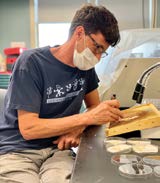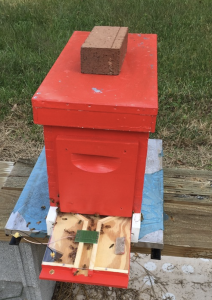Click Here if you listened. We’re trying to gauge interest so only one question is required; however, there is a spot for feedback!
Read along below!
Found in Translation
Climate Control
 By: Jay Evans, USDA Beltsville Bee Lab
By: Jay Evans, USDA Beltsville Bee Lab
Honey bees control the temperature in the core of their colonies to a degree you can only dream of for your home. By humming muscles (burning sugary carbs) and ventilating, they stabilize both temperature and humidity across a wide range of outside conditions. How they do this and the causes of major shifts from normal hive conditions are topics of great interest for colony health. Running too hot in the Winter can stress the cells of bees, or at least reflect the wasteful use of honey. Running too cold also stresses bees, especially brood, and can put colonies at greater risk from parasites and pathogens (which tend to come from lineages that exploit less hot-blooded insects).
Beekeepers and scientists have developed and adopted numerous technologies for monitoring hive conditions. Superfans can find hours of videos by experts in this realm from the most recent International Bee and Hive Monitoring Conference, held at the University of Montana (https://www.youtube.com/playlist?list=PLK1L4YyuyoO1WxuH1Dg4sxhM-FOEDYhW_). Highly accurate thermocouples are inexpensive and depend on minimal energy. Similarly, monitors for humidity are readily available, as are monitors for sound. Slightly more complex probes can determine relative levels of oxygen or CO2 in the hive environment. All of these measurements can be reported out to the wider world via antennae aimed at cell phone towers or satellites, joining the cacophony of the ‘Internet of Things’.
Scientists using this technology receive unprecedented insights into how colony conditions, management and hive materials impact the bubble in which colonies live. In total, the results have some bearing on management and diagnoses of when things are going poorly. They also might change how you manage, feed and house your bees. The concept of indoor weather reports from beehives is not new, of course. Hive temperature values gathered by James Simpson for his 1961 paper Nest Climate Regulation in Honey Bee Colonies (https://www.science.org/doi/10.1126/science.133.3461.1327) are still accepted as truth for colonies in Winter and Summer and within and outside the cluster of bees. Namely, the cluster itself is HOT, and stable, fluctuating only slightly from 34oC (93oF). This cluster temperature trends lower and becomes a bit less stable in the absence of brood, but Winter bees from Texas to Toronto keep things amazingly hot and stable through the coldest Winter.
 So how do beekeepers help their colonies control temperatures efficiently? I have written before about the resurgence in storing colonies in buffered buildings, or underground, during Winter as a means of decreasing stress and honey consumption. What about hive-centered fixes? Working from the outside in, what is it about the hive environment that helps honey bees regulate their inner selves? For any given climate, bees and beekeepers have some say about the building materials and integrity of colony homes. Some beekeepers feel that natural hive cavities and managed hive bodies that most closely match the ancestral homes of honey bees will lead to healthier bees. Groups such as Apis arborea (https://www.apisarborea.org) are leaning into this idea with naturalistic beekeeping. Others have focused on mass-produced and marketed options. My USDA colleagues Mohamed Alburaki and Miguel Corona have compared the well-used wooden Langstroth hive body to one of the available synthetic hive options. Using bee-free boxes and cold stretches of the Maryland Winter, they showed that synthetic boxes absorbed and maintained solar energy more effectively and (counter-intuitively to me) also kept the hive environment at lower humidity at a range of temperatures (Polyurethane honey bee hives provide better Winter insulation than wooden hives, 2022, open-access in Journal of Apicultural Research, https://doi.org/10.1080/00218839.2021.1999578). These are both desirable traits for a hive structure. Similarly, Daniel Cook and colleagues from Brisbane, Australia, showed in Thermal impacts of apicultural practice and products on the honey bee colony (2021, Journal of Economic Entomology, doi: 10.1093/jee/toab023) that polystyrene hives maintained heat far better than wooden hives, while also showing that stored honey, while costly to heat initially, acted as wonderful insulation for bees trying to keep warm. In prior work, Yasar Erdogran from Turkey did a similar study but with bee-filled colonies (Comparison of colony performances of honey bee (Apis mellifera L.) housed in hives made of different materials, 2019, in the obscure but accessible Italian Journal of Science, https://doi.org/10.1080/1828051X.2019.1604088). Here, polyurethane colonies had higher brood production and honey yields than wooden hives, but wooden hives with an exterior sandwich of insulation were significantly better than both, even during the Summer.
So how do beekeepers help their colonies control temperatures efficiently? I have written before about the resurgence in storing colonies in buffered buildings, or underground, during Winter as a means of decreasing stress and honey consumption. What about hive-centered fixes? Working from the outside in, what is it about the hive environment that helps honey bees regulate their inner selves? For any given climate, bees and beekeepers have some say about the building materials and integrity of colony homes. Some beekeepers feel that natural hive cavities and managed hive bodies that most closely match the ancestral homes of honey bees will lead to healthier bees. Groups such as Apis arborea (https://www.apisarborea.org) are leaning into this idea with naturalistic beekeeping. Others have focused on mass-produced and marketed options. My USDA colleagues Mohamed Alburaki and Miguel Corona have compared the well-used wooden Langstroth hive body to one of the available synthetic hive options. Using bee-free boxes and cold stretches of the Maryland Winter, they showed that synthetic boxes absorbed and maintained solar energy more effectively and (counter-intuitively to me) also kept the hive environment at lower humidity at a range of temperatures (Polyurethane honey bee hives provide better Winter insulation than wooden hives, 2022, open-access in Journal of Apicultural Research, https://doi.org/10.1080/00218839.2021.1999578). These are both desirable traits for a hive structure. Similarly, Daniel Cook and colleagues from Brisbane, Australia, showed in Thermal impacts of apicultural practice and products on the honey bee colony (2021, Journal of Economic Entomology, doi: 10.1093/jee/toab023) that polystyrene hives maintained heat far better than wooden hives, while also showing that stored honey, while costly to heat initially, acted as wonderful insulation for bees trying to keep warm. In prior work, Yasar Erdogran from Turkey did a similar study but with bee-filled colonies (Comparison of colony performances of honey bee (Apis mellifera L.) housed in hives made of different materials, 2019, in the obscure but accessible Italian Journal of Science, https://doi.org/10.1080/1828051X.2019.1604088). Here, polyurethane colonies had higher brood production and honey yields than wooden hives, but wooden hives with an exterior sandwich of insulation were significantly better than both, even during the Summer.
Other studies suggest that bees themselves, and their behaviors, are predominant in maintaining a cozy home. Using longterm and precise reporting of temperature and levels of CO2, William Meikle and colleagues showed how bees can make different houses work for them in Honey bee colonies maintain CO2 and temperature regimes in spite of change in hive ventilation characteristics, 2022, Apidologie, https://doi.org/ 10.1007/s13592-022-00954-1). Bees showed a narrow core temperature band in both standard hives and hives with a screen bottom board, and strong daily cycles in CO2. Colonies had higher CO2 levels when housed with screen bottom boards but this difference was not as large as the natural daily cycling of CO2. Dashing a good story, colonies did not show any sort of group-level ‘breathing,’ whereby gas levels changed on a cycle from seconds to hours. Building on the complexity and seasonal nature of all this, Ugoline Godeau and French colleagues monitored the temperatures of different parts of dozens of hives for two years (!), giving the best view yet of energy loss and heat production within bee homes. In their 2022 pre-print study Stability in numbers: a positive link between honey bee colony size and thermoregulatory efficiency around the brood (https://ecoevorxiv.org/9mwye/) they reinforce how remarkably stable hive temperatures remain, while showing minor changes with colony size, namely that worker bee population, and not brood numbers, per se, is positively tied to temperature stability. This is only true when brood is present and when probes are in areas containing brood. When brood is absent, as observed 60 years ago by Simpson, hive temperatures fluctuate madly.
So how can this information be used to improve beekeeping? It is evident that hive sensors can help determine optimal bee houses for any given climate, and perhaps these sensors will help beekeepers decide when and how to remove honey and swap out drawn frames for foundation with the least impact on the bubble their bees prefer. It is possible that multiple hive temperature sensors can tell beekeepers when brood is absent or retracting, but bees seem to be quite good at showing heat when even small patches of brood are present. Hive sensors that measure CO2 and other hive gases (oxygen, nitrogen, etc.) are more costly but give unique insights into bee activity, and perhaps the efficient use by bees of incoming energy. How these physical measures mesh with continuous monitoring of hive weight, and sound for that matter, remains to be seen. For now, for most of us, we can get general insights from studies that use accurate and constant probes, but our most useful insights (and satisfaction) will come from lifting hive covers.








